Day 12: Oxford, MS

We chose Oxford, MS as a road trip destination pretty arbitrarily – I wanted to go to a smaller town somewhere in the Deep South, as I was keen for the trip to be a mix of cities, small towns and wilderness, and so far we had only been to cities – even the smallest city we had been to, Corpus Christi, still has over 300 000 inhabitants. By contrast Oxford, MS has just over 20 000 inhabitants. When looking for small Southern towns to go to Oxford leapt out at us because it was the home of William Faulkner, and his house is still there, preserved as it was on the day he died (apparently), and you can look round it. I can’t claim to be a big Faulkner fan, but I did read As I Lay Dying while at university and it increased my fascination with the American South, and have been meaning to read The Sound and the Fury ever since we studied Macbeth and my GCSE English teacher told us Faulkner’s novel was named after a line in my favourite soliloquy from the play:
To-morrow, and to-morrow, and to-morrow,
Creeps in this petty pace from day to day,
To the last syllable of recorded time;
And all our yesterdays have lighted fools
The way to dusty death. Out, out, brief candle!
Life’s but a walking shadow, a poor player,
That struts and frets his hour upon the stage,
And then is heard no more. It is a tale
Told by an idiot, full of sound and fury,
Signifying nothing.
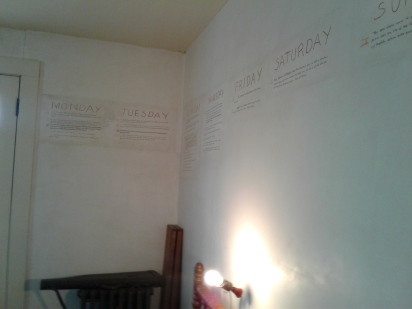
When there’s not much to choose between a bunch of Southern towns that you’ve never heard of, something as small as a house belonging to a Nobel prize-winning author who you’ve only read one novel by is enough to make you decide to go there. Oxford can’t really claim to be a typical Southern town – it’s distinguished by the fact that it is home to the University of Mississippi, so it is actually a rather studenty town. This gives the place a rather odd feel, because while it is small and Southern in some respects with a charming town square, said town square suddenly filled up on Friday evening with loud frat boys getting drunk.
The only other thing I would add about Oxford, MS is that Bill Bryson writes about it in
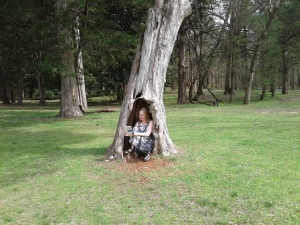
possibly my favourite of his travel books, and one of the big inspirations for this road trip, ‘The Lost Continent: Travels in Small-Town America’. This didn’t contribute to our decision to go there, because I had actually forgotten that he mentions it in the book until Gwynnie reminded me, but it did somehow re-confirm that we had made a good choice.
In the book, Bill Bryson remarks that the town is called Oxford because the townsfolk thought that naming it after a city with a famous university in England would convince the state of Mississippi to let them build the university in their town, and it worked. According to Bill Bryson, ‘This tells you most of what you need to know about the workings of the Southern mind.’ A bit of a damning judgement. We decided to go in with an open mind. His main impression of the place is that people’s accents are really hard to understand; he has an encounter with a policeman where he has to ask the man to repeat himself three times, and after asking directions to William Faulkner’s house at the tourist information office and not understanding the answer, he ends up not going there at all. I have to say, I didn’t find the accents hard to understand – they were Southern, sure, but not hard to understand. But I’ll give Bill the benefit of the doubt and say that perhaps things have changed since 1987 when he did his trip 😉
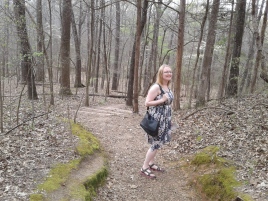
It was a 5 hour drive from New Orleans to Oxford, so it was already afternoon by the time we arrived. We were anxious to arrive before 4pm when Faulkner’s house closes for public viewing, but we ended up arriving in plenty of time. Admission was only $5. We looked round the house and grounds and went for a little walk in the surrounding woods towards the university.
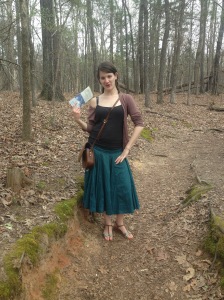
Afterwards, we met our couchsurf host at his house – his family is actually from Thailand, and I have to say I was a bit surprised that a Thai family would choose to live in Oxford, Mississippi, but why not I suppose – people end up in the most random places! My parents are from the Czech Republic and Slovakia and they ended up in Ashford, Kent, so y’know.
He took us to the Square, the only other thing worth seeing in Oxford apart from Faulkner’s house and the university campus. It’s a fairly charming town square, but I have to say, not as charming as I was expecting from all the fuss that everyone made about it. Perhaps it was just that the weather was a bit grey and cloudy while we were there – I’m sure I would have found it more impressive in the sunshine. It did, however, have a British-style red telephone box.
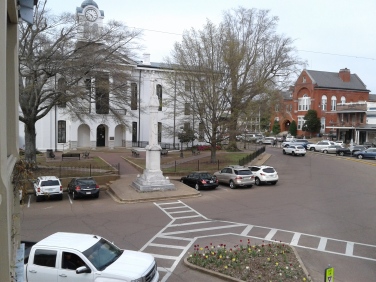
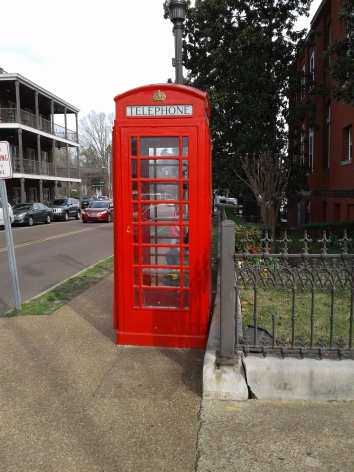
The other thing Oxford has is a very lovely independent bookshop and cafe called Square Books. We spent some time here drinking coffee and updating our blog.

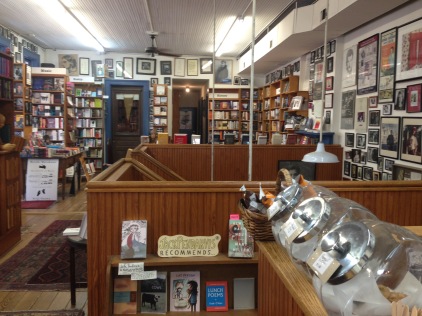
I also saw this sign on the wall:
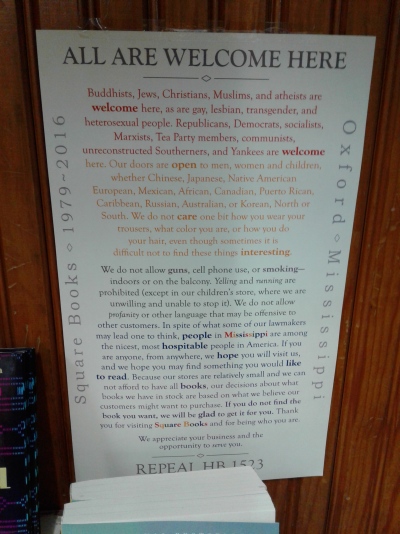
If anyone needed any indication that Mississippi has changed since the 1960s, when lynchings were still not uncommon and white people rioted at the thought that they would have to start sharing their buses and schools with black people, here it was. It warmed my heart 🙂 It is pretty amazing that within a couple of generations you find a sign like this in a small town in Mississippi, when sixty years ago you would have seen signs telling you which entrance you could go into if you were a ‘white’ or if you were a ‘colored’ person.
But the South is still a place that many Americans from other parts of the US are afraid to go to. The most common reaction from Americans not from the South when we told them we were going to Mississippi and Alabama was along the lines of ‘Why?’ or a sarcastic, ‘Good luck!’ But if you questioned them on it most of them had never actually been to the South. People assume that time has stood still in the South and nothing has moved on in the last sixty years, but of course it has. Admittedly it’s possible that we went to an extremely liberal enclave within Mississippi – after all, it is a university town. But still, it shows that the South isn’t all guns and rednecks and racism.
After coffee and a bit of computer time, we went to the restaurant owned by our couchsurf host’s family – a lovely Thai restaurant called Rice & Spice. We had some American-style Thai food, and since our couchsurf host was waiting on us he gave us free dessert 🙂 We had a quiet night in that evening and were lulled to sleep at night by the pleasant sounds of a thunderstorm.
Day 13: Birmingham, AL
I chose Birmingham as a road trip destination for a much more specific reason – the Civil Rights Movement had been my absolute favourite thing that I had studied in history at school, and Birmingham was not only an important city in the Civil Rights Movement, but is now the home of the Civil Rights Institute. I loved learning about this period of history at school.
I remember poring over my history book and reading it cover to cover – everything from slavery to the Civil War to Reconstruction to Jim Crow. It was unbelievable and fascinating and hard to fathom for me that there had really been a time in such recent memory when people had owned other people and that was considered normal. It almost seemed like it couldn’t be real. And yet it had been. But then many things that I learned about in history seemed like they couldn’t be real to my young mind – things like a government deciding to build a wall to divide a city in two and stop people going between the two parts for forty years. And yet this too had happened. Learning about these things was what convinced me that other people are crazy.
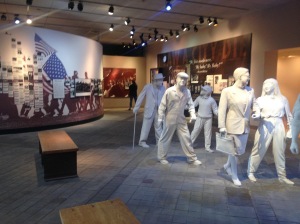
The history of what led up to the Civil Rights Movement is horrifying, unbelievable and fascinating, but the history of the Civil Rights Movement itself is amazing and inspiring. Although I had learned all about it in school and still remembered most things pretty well even now ten years later because it had made such a strong impression on me, I still spent a long time in the Civil Rights Institute poring over everything – 3.5 hours to be exact. Actually, I could have spent longer – the place is vast and has so much information you could probably spend a whole day in there. It has a brief section at the beginning about what life was like in the South under segregation and Jim Crow, and then moves on to exploring the birth of the Civil Rights Movement in the 50s, right through to the end of the 60s. It covers everything in great detail and in a range of media.

I have to admit that I got a bit teary watching the Martin Luther King ‘I have a dream’ speech, even though I’ve seen it many times. It never fails to astound me how passionate, organised and dedicated the leaders and participants of the Civil Rights Movement were, what a sustained effort over a great number of years they had to make and what strength of vision they must have had to imagine a world so very different from the one they were currently living in to bring it into being.
After 3.5 hours my vision was getting a little blurry from hunger, Gwynnie had already left in search of food, and a massive rainstorm had hit Birmingham, so I sort of skimmed through the last sections about what the lasting effects of the Civil Rights Movement were, Birmingham’s first black mayor in 1979, and other similar movements around the world that took inspiration from the Civil Rights Movement. I briefly took a picture of the 16th Street Baptist Church, just across the road from the Civil Rights Institute, before we left Birmingham – this was a significant place during the Civil Rights Movement because it served as a meeting place, rallying point, and organisational headquarters for the movement. Fred Shuttlesworth, instrumental in the movement, was the pastor there, and Martin Luther King, Jr. was a frequent speaker. It was also the site of the 1963 bombing by members of the Ku Klux Klan during which four young black girls died.
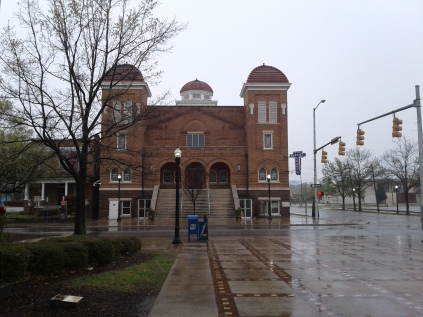
Gwynnie and I left Birmingham just as a huge thunderstorm started, so we didn’t get a chance to see any of it apart from the area around the Civil Rights Institute. We drove around for a while looking for food but something strange kept happening, where every time we found a restaurant on Google Maps that looked promising, we would drive to where it was supposed to be and find an empty parking lot or something and no restaurant anywhere to be seen. We concluded that either Google Maps was fucking with us, or that Birmingham is a barren wasteland. We left Birmingham hungry, filled with thoughts of the Civil Rights Movement, and trying desperately to see through the searing rain that was lashing our car and seriously impairing our visibility. I think it is no coincidence that Oxford and Birmingham, named after cities in the UK, were the only two places on this trip so far where we experienced bad weather.


I’m so glad ya’ll see what us Southerners see: the beauty in a place that *is* so marked with racist History, but has certainly tried its best to progress. We still have far to go (but arguably, so does many parts of the country). I love seeing small towns here & there-it’s such a balance to city life. Sorry Alabama didn’t feed you as well as NOLA did, but I did have a few beignets in ya’ll honour 🙂
Keep the stories coming, I love following ya’lls adventures!
Love,
Kristin & New Orleans
LikeLike